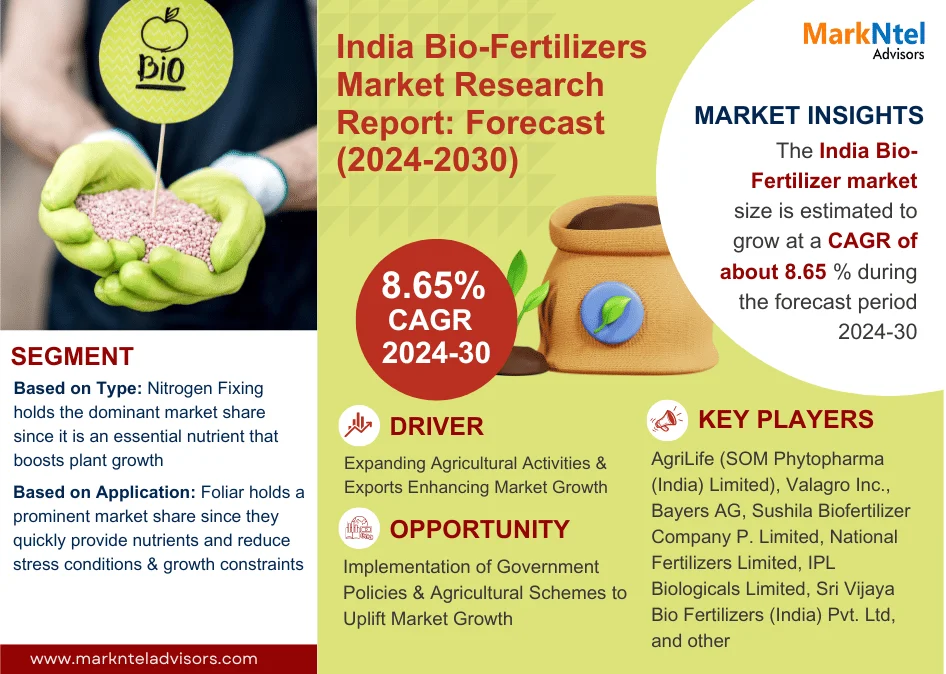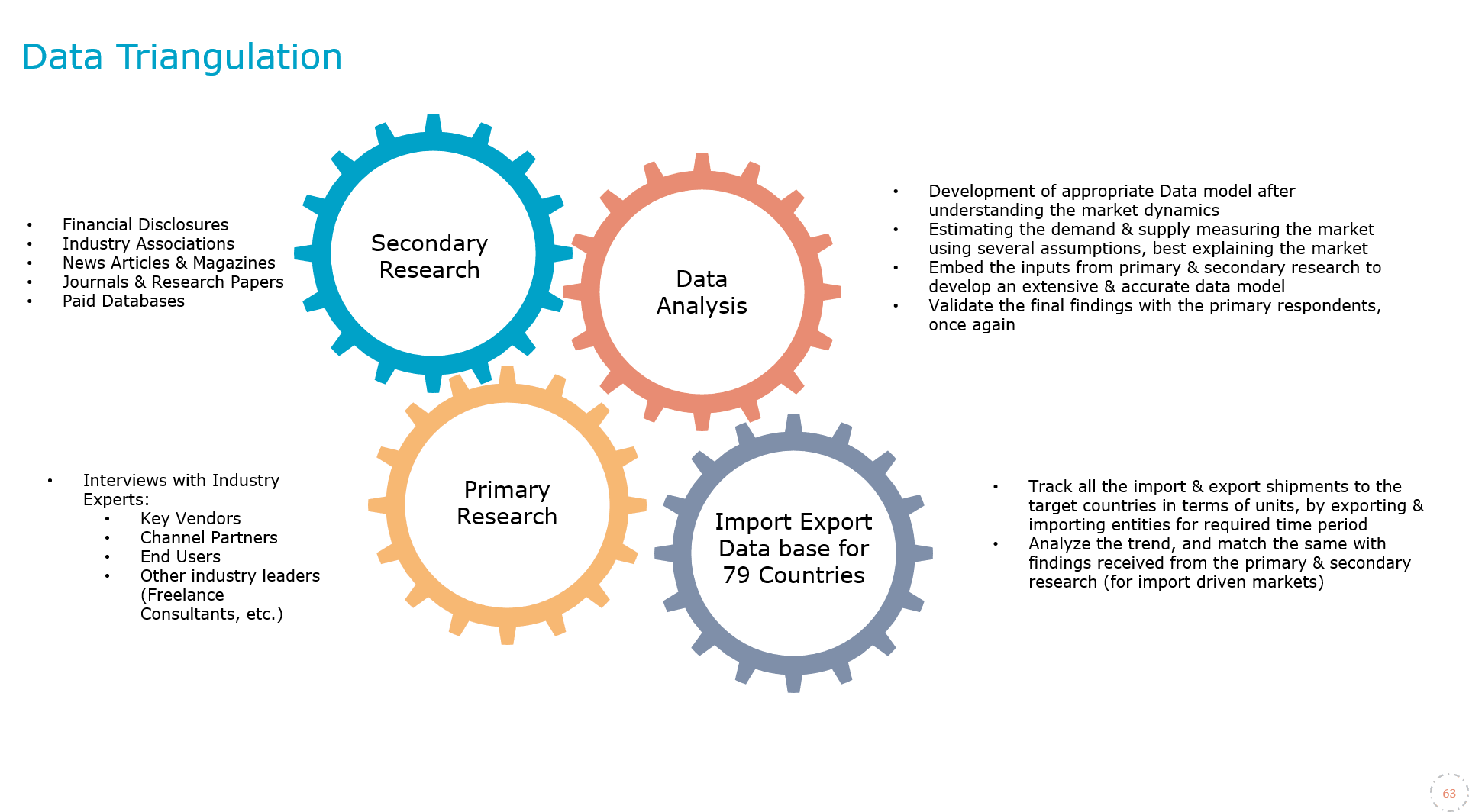
India Bio-Fertilizers Market Research Report: Forecast (2024-2030)
India Bio-Fertilizers Market Share, Size, Analysis, Report - By Microorganisms (Rhizobium, Azospirillum, Azotobacter, Acetobacter, Others (Vesicular Arbuscular Mycorrhizae (VAM), B...acillus, etc.)), By Type (Nitrogen Fixing, Phosphate Solubilizing, Others (Zinc-solubilizing, Potassium-mobilizing bio fertilizers, etc.)), By Application (Foliar, Soil Treatment, Seed Treatment), By Crop Type (Fruits, Vegetables, Cereals & Grains, Turfs, Ornamentals, Other (Oil Seeds, Pulses, etc.)), and Others Read more
- Environment
- Jan 2023
- Pages 101
- Report Format: PDF, Excel, PPT
Market Definition
Bio-fertilizers are natural fertilizers, usually derived from organic material & microbes. They are added to the soil to promote the growth of plants and trees. These substances have microbes that provide essential nutrients responsible for the plant growth.
Market Insights & Analysis: India Bio-Fertilizers Market (2024-30):
The India Bio-Fertilizer market size is estimated to grow at a CAGR of about 8.65% during the forecast period 2024-30. The growing awareness about environmental sustainability, increasing concern towards soil health & fertility, and rising fruit & vegetable quality concerns are uplifting the demand for bio-fertilizers in India.
Traditionally, unsustainable farming practices were used frequently for plant cultivation in India. In 2022, approximately 40% of the total cultivated area is being treated with chemical-based pesticides, per the National Institutes of Health. These practices involved excessive usage of chemicals. Therefore, the surging chemicals-based fertilizer usage to promote plant growth negatively impacts soil health. Per the National Bureau of Soil Survey and Land Use Planning, in 2023, approximately 146.8 million hectares, i.e., around 30% of the soil in India are contaminated. Thus, to enrich the soil with important nutrients, growers are minimizing the usage of chemical-based pesticides and using bio-fertilizers, driving the India Bio-Fertilizers Market.
| Report Coverage | Details |
|---|---|
| Study Period | Historical Data: 2019-22 |
| Base Year: 2023 | |
| Forecast Period: 2024-30 | |
| CAGR (2024-2030) | 8.65% |
| Regions Covered | North, East, West, South |
| Key Companies Profiled | AgriLife (SOM Phytopharma (India) Limited), Valagro Inc., Bayers AG, Koppert Biological Systems, United Phosphorus Ltd, Hifield Organics Inc., Biostadt India Limited, Sushila Biofertilizer Company P. Limited, National Fertilizers Limited, IPL Biologicals Limited, Sri Vijaya Bio Fertilizers (India) Pvt. Ltd, and other. |
| Unit Denominations | USD Million/Billion |
In addition, unsustainable farming practices, deforestation, improper irrigation, and climate-related factors are increasingly contributing to soil erosion in India. The soil erosion is leading to the loss of topsoil containing nutrients in India. In 2023, around 30% of the Indian soil is registering soil erosion & about 3% of the total soil is witnessing critical topsoil loss, as per the Down to Earth Organization. This increasing topsoil is concerning for the farmers since it is making the soil deficient in nitrogen & phosphorus, responsible for plant growth. Therefore, to provide pivotal nutrients to the plants, the farmers are inclined towards the bio-fertilizers, driving the India Bio-Fertilizers market.

In addition, the agricultural yields in India contribute significantly to the overall GDP of the country. Farming and its allied sectors contributed around 18.3% of the overall Gross Value Added (GVA) in the Indian economy, as per the Ministry of Statistics & Programme Implementation (MoSPI). Therefore, to uplift the Indian economy, the official authorities are encouraging agricultural practices. Along with this, the governing bodies are also providing incentives & subsidies to the agriculturalists to buy natural composts to enhance plant growth. This increasing implementation of the government's favorable agricultural scheme would continue to boost the sales of biofertilizers, augmenting India's Bio-Fertilizers market in the forecast years as well.
India Bio-Fertilizers Market Driver:
Expanding Agricultural Activities & Exports Enhancing Market Growth – In recent years, India has witnessed population growth & surge in urbanization rate. The total population of India is estimated to be around 1.42 billion in 2023, an increase of about 11 million compared to the previous year, stated the World Bank. This, is in turn, raising the demand for agricultural food products like fruits & vegetables. Hence, farming activities in India are increasing to fulfill the requirement for edible products.
The country has signed preferential trade agreements with countries like the US, the UAE, etc., owing to which it sends off a significant amount of agricultural products to these neighboring countries. The trade of the products also strengthens the economy. Therefore, during 2019-2023, the country exported higher agricultural products to rebuild its economy. Hence, to fulfill the growing local & global demand for food products, farming in India has been on the rise. Based on statistics by the Press Information Bureau (PIB), the total food grains production in FY2023 reached 329.7 million tonnes, an increase of about 14.1 million tonnes compared to the previous year. The farmers are using natural composts since these organic substances help facilitate plant growth faster & maintain the soil quality. Therefore, the rising agricultural activities within India are increasing the need for Bio-fertilizers, driving India's Bio-fertilizer Market.
India Bio-Fertilizers Market Opportunity:
Implementation of Government Policies & Agricultural Schemes to Uplift Market Growth– Agriculture in India is widely dependent upon climatic conditions, like monsoon. As of 2023, 55% of India's net sown area is rain-dependent, as per the Down to Earth Organization. Therefore, variability in monsoon patterns, including delayed onset, early withdrawal, or erratic rainfall distribution, impacts crop yields. In addition, several regions in India have limited irrigation infrastructure. Therefore, uneven rainfall patterns in these regions & water scarcity result in low crop growth rates and food insecurity. Hence, to enhance food security within the country, the government of India is encouraging agricultural practices. The official authorities are increasingly laying initiatives & providing subsidies to the farmers to improve agricultural output by using bio-fertilizers. For instance,
- In 2023, The Government of India approved the PRANAM (PM Programme for Restoration, Awareness, Generation, Nourishment, and Amelioration of Mother Earth). The aim is to promote the use of nutrient-based & bio-fertilizers for sustainable agriculture practices across India.
These initiatives prioritize soil fitness control and advocate for the judicious use of natural inputs & bio-fertilizers. Therefore, the rising implementation of the schemes to maintain soil health & ensure food security within the country would enhance the requirement for bio-fertilizers. Consequently, this would pose an opportunity for the market players to supply their bio-based fertilizers to the farmers, uplifting the India Bio-Fertilizers market.
India Bio-Fertilizers Market Challenge:
Inclination Towards Low-Cost Traditional Chemicals Hinder the Market Growth– Bio-fertilizers are developed using organisms, such as beneficial bacteria, fungi, or enzymes, & require specific conditions, like balanced temperature & pH. Along with this, the production of bio-fertilizers requires specialized equipment, laboratory facilities, and skilled personnel. As a result, the production cost of bio-fertilizers is relatively higher. Therefore, to earn a profit & have economies of scale, the major players in the India Bio-Fertilizers market sell their products at higher costs. The cost of conventional fertilizer in India is approximately USD0.066/Kg, whereas the price of bio-fertilizer is about USD2.04/Kg. As a result, the farmers usually buy traditional chemicals rather than bio-fertilizers, hindering market growth.
Furthermore, the bio-fertilizers are manufactured using living microbes. Therefore, the life shelf of bio-fertilizers is comparatively lower than the traditional chemicals. Hence, the farmers seek to use conventional chemicals. In addition, these fertilizers require careful handling & storage space, an additional overhead cost for the farmers. Hence, the farmers look out for chemical fertilizers that are easy to use, low priced, and have a higher shelf life, slowing down the sales of bio-fertilizers in India.
India Bio-Fertilizers Market (2024-30): Segmentation Analysis
The India Bio-Fertilizers Market study of MarkNtel Advisors evaluates & highlights the major trends & influencing factors in each segment & includes predictions for the period 2024–2030 at national levels. Based on the analysis, the market has been further classified as:
Based on Type:
- Nitrogen Fixing
- Phosphate Solubilizing
- Others (Zinc-solubilizing, Potassium-mobilizing bio fertilizers, etc.)
Among them, Nitrogen Fixing holds the dominant market share since it is an essential nutrient that boosts plant growth. Nitrogen is essentially required for higher agricultural yields of products such as Rice, Wheat, Pulses & Vegetables. However, poor management of crop residues and organic matter removal from the soil has resulted in nitrogen losses. Thus, to fulfill the demand for vital minerals, agriculturalists in India are using Nitrogen-Fixing Bio-fertilizers, enhancing their market share.
In addition, nitrogen also helps to improve soil productivity, fosters sustainable agriculture practices, and eradicates soil degradation associated with excessive use of conventional pesticides. Therefore, the farmers shifting towards sustainable farming are incorporating nitrogen-fixing bio-fertilizers into their agricultural practices, uplifting market growth.
Based on Application:
- Foliar
- Soil Treatment
- Seed Treatment
Of them, Foliar holds a prominent market share since they quickly provide nutrients and reduce stress conditions & growth constraints. Moreover, foliar application allows the farmers to target the delivery of specific nutrients, such as micronutrients like zinc, iron, manganese, etc., essential for plant growth. Therefore, the end users usually choose to apply bio-fertilizers on plant leaves through sprays, enhancing the share of Foliar in India's Bio-Fertilizers market.
In addition, the foliar improves plant resistance to pests and diseases, reducing reliance on chemical pesticides and promoting eco-friendly pest control measures. As a result, farmers integrate the bio-fertilizers with their pest management & nutrient supply strategies. Moreover, foliar-applied bio-fertilizers reduce plant stress by inducing systemic resistance & enhancing antioxidant activity. Therefore, farmers that opt for integrated nutrient control prefer to apply bio-fertilizers on the plant leaves, uplifting the market share of Foliar in India's Bio-Fertilizers market.
India Bio-Fertilizers Market Industry Recent Development:
- 2023: Indian Farmers Fertilizer Cooperative (IFFCO): Procured around 2,500 agri-drones to spray nano fertilizers, bio-stimulants, and bio-fertilizers to enhance plant growth in the country.
Gain a Competitive Edge with Our India Bio-Fertilizers Market Report
- India Bio-Fertilizers Market Report by MarkNtel Advisors provides a detailed & thorough analysis of market size & share, growth rate, competitive landscape, and key players. This comprehensive analysis helps businesses gain a holistic understanding of the market dynamics & make informed decisions.
- This report also highlights current market trends & future projections, allowing businesses to identify emerging opportunities & potential challenges. By understanding market forecasts, companies can align their strategies & stay ahead of the competition.
- India Bio-Fertilizers Market Report aids in assessing & mitigating risks associated with entering or operating in the market. By understanding market dynamics, regulatory frameworks, and potential challenges, businesses can develop strategies to minimize risks & optimize their operations.
Frequently Asked Questions
- Market Segmentation
- Introduction
- Research Process
- Assumption
- Market Definition
- Executive Summary
- India Bio-Fertilizers Market Value Chain Analysis
- India Bio-Fertilizers Market Regulation & Policy
- India Bio-Fertilizers Market Trends & Insights
- India Bio-Fertilizers Market Dynamics
- Growth Drivers
- Challenges
- India Bio-Fertilizers Market Hotspot and Opportunities
- India Bio-Fertilizers Annual Production, By States, 2018-2022
- India Bio-Fertilizers Market Outlook, 2019-2030
- Market Size and Analysis
- By Revenues (USD Million)
- By Volume (Thousand Tons)
- Market Share and Analysis
- By Microorganisms
- Rhizobium
- Azospirillum
- Azotobacter
- Acetobacter
- Others (Vesicular Arbuscular Mycorrhizae (VAM), Bacillus, etc.)
- By Type
- Nitrogen Fixing
- Phosphate Solubilizing
- Others (Zinc-solubilizing, Potassium-mobilizing bio fertilizers, etc.)
- By Application
- Foliar
- Soil Treatment
- Seed Treatment
- By Crop Type
- Fruits
- Vegetables
- Cereals & Grains
- Turfs
- Ornamentals
- Other (Oil Seeds, Pulses, etc.)
- By Region
- North
- East
- West
- South
- By Company
- Competition Characteristics
- Revenue Shares & Analysis
- By Microorganisms
- Market Size and Analysis
- India Bio-Fertilizers Market Key Strategic Imperatives for Success and Growth
- Competitive Outlook
- Competition Matrix
- Application Portfolio
- Brand Specialization
- Target Markets
- Target Applications
- Research & Development
- Strategic Alliances
- Strategic Initiatives
- Company Profiles (Business Description, Application Segments, Business Segments, Financials, Strategic Alliances/ Partnerships, Future Plans)
- Indian Farmers Fertilizer Cooperative (IFFCO)
- AgriLife (SOM Phytopharma (India) Limited)
- Valagro Inc.
- Bayers AG
- Koppert Biological Systems
- United Phosphorus Ltd
- Hifield Organics Inc.
- Biostadt India Limited
- Sushila Biofertilizer Company P. Limited
- National Fertilizers Limited
- IPL Biologicals Limited
- Sri Vijaya Bio Fertilizers (India) Pvt. Ltd
- Others
- Competition Matrix
- Disclaimer
MarkNtel Advisors follows a robust and iterative research methodology designed to ensure maximum accuracy and minimize deviation in market estimates and forecasts. Our approach combines both bottom-up and top-down techniques to effectively segment and quantify various aspects of the market. A consistent feature across all our research reports is data triangulation, which examines the market from three distinct perspectives to validate findings. Key components of our research process include:
1. Scope & Research Design At the outset, MarkNtel Advisors define the research objectives and formulate pertinent questions. This phase involves determining the type of research—qualitative or quantitative—and designing a methodology that outlines data collection methods, target demographics, and analytical tools. They also establish timelines and budgets to ensure the research aligns with client goals.
2. Sample Selection and Data Collection In this stage, the firm identifies the target audience and determines the appropriate sample size to ensure representativeness. They employ various sampling methods, such as random or stratified sampling, based on the research objectives. Data collection is carried out using tools like surveys, interviews, and observations, ensuring the gathered data is reliable and relevant.
3. Data Analysis and Validation Once data is collected, MarkNtel Advisors undertake a rigorous analysis process. This includes cleaning the data to remove inconsistencies, employing statistical software for quantitative analysis, and thematic analysis for qualitative data. Validation steps are taken to ensure the accuracy and reliability of the findings, minimizing biases and errors.

4. Data Forecast and FinalizationThe final phase involves forecasting future market trends based on the analyzed data. MarkNtel Advisors utilize predictive modeling and time series analysis to anticipate market behaviors. The insights are then compiled into comprehensive reports, featuring visual aids like charts and graphs, and include strategic recommendations to inform client decision-making









